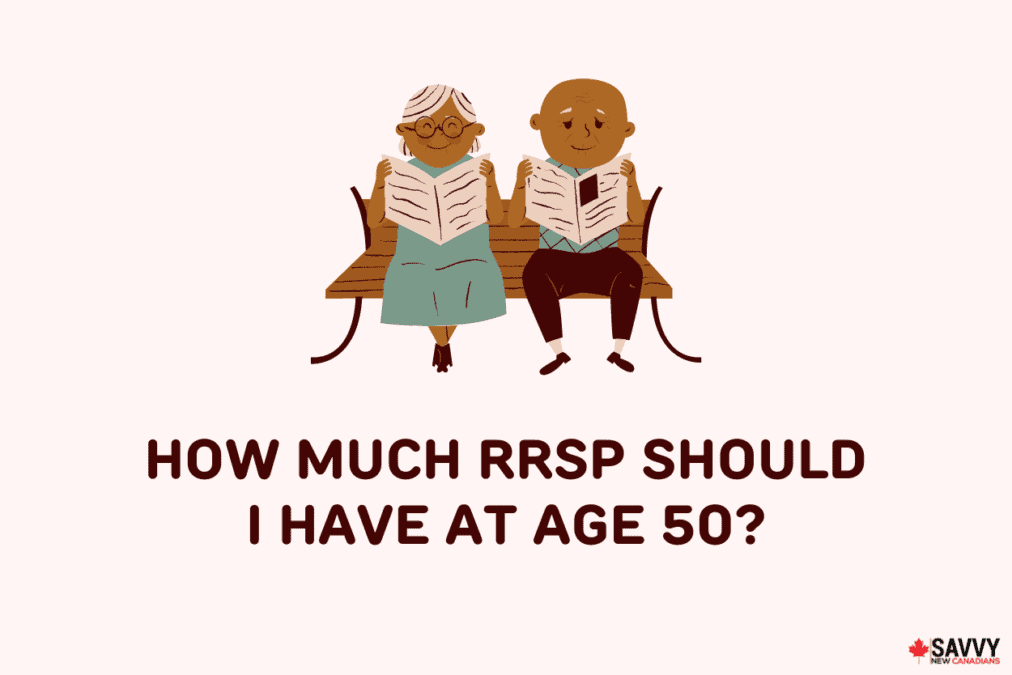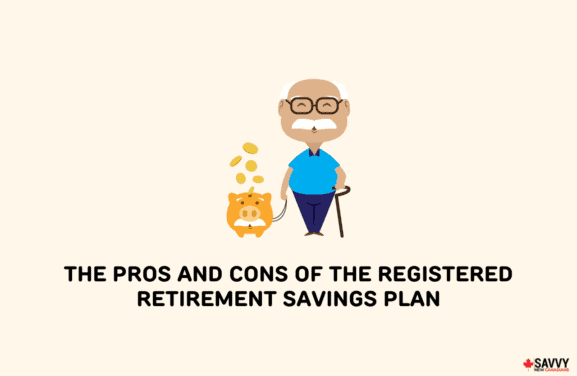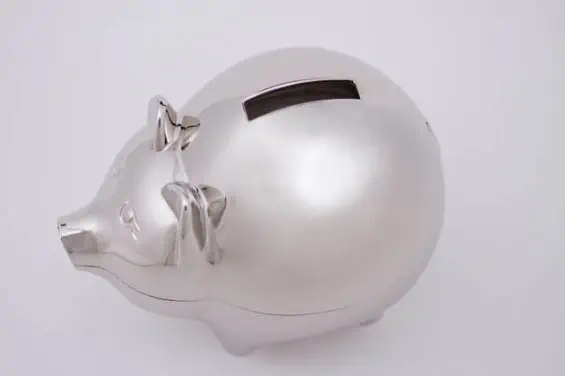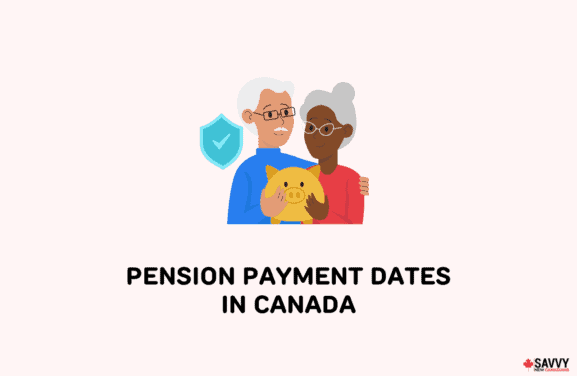How much money should you have saved in your RRSP at age 50?
One of the top questions Canadians ask themselves at various life stages (30, 40, 50, or 60) is how much money they should have saved for retirement.
And, since the Registered Retirement Savings Plan (RRSP) is considered the default retirement account, people use its value to assess their readiness for retirement.
This article will cover how much money you should have in your RRSP by age 50, how to calculate your retirement income needs and more.
Retirement Savings By Age
While I focus on RRSP savings here, your retirement savings will likely include other income sources and tools such as the Tax-Free Savings Account (TFSA), and government-administered pension plans (OAS and CPP), and workplace retirement plans.
When all of them are combined, your RRSP needs may be much less.
As shown in this article on retirement savings by age, Fidelity suggests you plan to have the following multiples of your salary at certain age thresholds:
Table 1:
| Your Age | Retirement Savings |
| 30 years | 1 x income |
| 35 years | 2 x income |
| 40 years | 3 x income |
| 45 years | 4 x income |
| 50 years | 6 x income |
| 55 years | 7 x income |
| 60 years | 8 x income |
| 67 years | 10 x income |
Since the Fidelity benchmarks can be a bit challenging to meet in the early years, I have provided alternative benchmarks as provided by T. Rowe Price and will use these for estimating how much RRSP savings you should aim to have at age 50.
Table 2:
| Investor’s Age | Savings Benchmark | Midpoint |
| 30 years | Half of Salary | 1/2x |
| 35 years | 1x to 1.5x salary | 1x |
| 40 years | 1.5x to 2.5x salary | 2x |
| 45 years | 2.5x to 4x salary | 3x |
| 50 years | 3x to 5.5x salary | 5x |
| 55 years | 4.5x to 8x salary | 7x |
| 60 years | 6x to 11x salary | 9x |
| 65 years | 7x to 13.5x salary | 11x |
How Much RRSP You Should Have at Age 50
At age 50, you should have about five times your annual income in retirement savings.
Agreeing on an exact amount everyone needs to have in their RRSP at age 50 is not possible or practical. It can, however, be useful to have an estimate or multiple that serves as a benchmark to compare yourself to.
To do this, let us look at the average and median annual incomes of Canadians in the 45 to 54 years range.
As per Statistics Canada in 2020 (their most recent data):
- Average annual income of 45 to 54 years age group: $67,400
- Median annual income for 45 to 54 years age group: $53,900
Using the average amount and the multiple in Table 2, you should have around $337,000 by age 50 (i.e. 5 x $67,400).
If we use the median number, which excludes the highest earners, you should have around $269,500 saved at age 50 (calculated as 5 x $53,900).
Table 3:
| Income Statistics | RRSP Target at Age 50 |
| Median income for age 45 to 54 | $269,500 |
| Average income for age 45 to 54 | $337,000 |
Assumptions:
- You are earning the median or average wage for your age group. If not, simply multiple your annual income by 5
- Your retirement savings can be spread across various accounts including RRSP, LIRA, workplace pensions, TFSAs, and non-registered investment accounts.

What If You Are Falling Behind at Age 50?
Hate to say it, but time is your best friend when it comes to investing for retirement.
If you haven’t started investing or have a significant gap between your expected vs. actual savings, you will need to buckle up.
Let us use a scenario to put things in perspective:
If you contribute $500 per month to an RRSP for 40 years, i.e. starting at age 25 until age 65, at a 5% annual rate of return, you will have $744,732 when you retire. In total, you would have contributed $240,000.
If you start investing at age 50 and contribute $1,333 per month until age 65, at a 5% annual rate of return, you will have $356,296 when you retire.
While both individuals contribute around $240,000 in total to their RRSPs, the person who started contributing at age 25 is richer by $388,436!
To achieve the same results, the older investor will need to contribute $2,786 per month.*
What are your options for catching up?
- Increase your savings rate and consider maximizing your TFSA contributions as well
- Delay retirement by a few years
- Consider a modest retirement: lower expenses = lower income needs
- Boost OAS and CPP by delaying your collection date
- Work part-time in retirement
How Much RRSP Do I Need To Retire?
If you have figured out how much income you will spend annually in retirement, you can use the examples below to calculate your retirement savings needs.
RRSP Needs For a Couple Example
Assuming a couple determines they need $70,000 per year to enjoy retirement.
If they qualify for the full OAS pension and get the average CPP benefit, they can expect a total annual pension amount of $35,319.84 (2024 numbers).
Table 4:
| Annual CPP | Annual OAS | Total | |
| Spouse 1 | $9,099.84 | $8,560.08 | $17,659.92 |
| Spouse 2 | $9,099.84 | $8,560.08 | $17,659.92 |
| Total | $35,319.84 |
Looking at their $70,000 annual income target, they have a shortfall of $34,680.16 (i.e. $70,000 – $35,319.84).
They will need an additional $867,004 in their combined investment accounts at age 65, using a 4% safe withdrawal rate.
The $867,004 can be held across their RRSP, TFSA, and/or employment pension plans.
RRSP Needs For a Single Individual Example
Assuming a single individual determines they need $40,000 per year to retire comfortably.
Based on the average CPP and full OAS pension as of 2023, they can expect a total annual pension amount of $17,659.92.
Looking at their $40,000 target, they have an annual income shortfall of $22,340.08 (i.e. $40,000 – $17,659.92), which has to be covered by other income sources.
As such, they will need an additional $558,502 in retirement savings, based on a 4% safe withdrawal rate.
To summarize:
Table 5:
| Single | Couple | |
| Retirement income need | $40,000 | $70,000 |
| Minus government pensions (OAS & CPP) | $17,659.92 | $35,319.84 |
| Minus TFSA investments | $0 | $0 |
| Minus employment pensions | $0 | $0 |
| Shortfall in retirement savings | $22,340.08 | $34,680.16 |
| Safe withdrawal rate | 4% | 4% |
| RRSP savings required | $558,502 | $867,004 |
Assumptions:
- These individuals are retiring at age 65 and qualify for OAS and CPP
- TFSA, workplace pensions, and non-registered savings are assumed to be $0
- We are using a 4% “safe withdrawal rate”
- “RRSP savings required” is calculated as the shortfall x 25 (or shortfall/4%)
- We have not considered taxes
RRSPs Explained
An RRSP (Registered Retirement Savings Plan) is an investment vehicle you can use to save for retirement on a tax-deferred basis.
Your contributions to this account are tax-deductible, and your gains are tax-free until you begin making withdrawals.
In addition to using an RRSP to save for retirement, you could also withdraw funds to buy a house (Home Buyer’s Plan) or to pay for full-time education or training for you or your spouse (Lifelong Learning Plan).
The maximum RRSP contribution limit in 2024 is $31,560.
RRSP Investments
You can hold different types of investments in your RRSP, including:
- Stocks
- Exchange-Traded Funds (ETFs)
- Mutual funds
- Guaranteed Investment Certificates (GICs)
- Bonds
- Savings
For a low-fee robo-advisor option, you can consider Justwealth.
Justwealth

Top-rated online wealth manager
Several customized portfolios & low fees
Unique RESP and other offerings
Auto rebalancing and div reinvesting
Earn up to a $500 bonus
Related:



